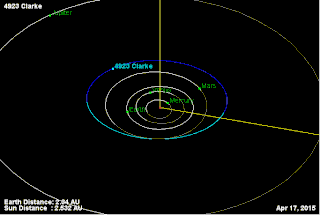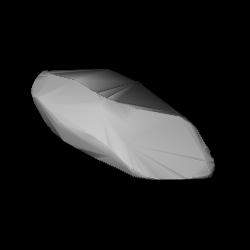Related Research Articles

4923 Clarke, provisional designation 1981 EO27, is a stony background asteroid from the inner regions of the asteroid belt, approximately 3.5 kilometers (2.2 miles) in diameter. It was discovered on 2 March 1981, by American astronomer Schelte Bus at the Siding Spring Observatory in Australia. The spheroidal S-type asteroid has a rotation period of 3.14 hours. It was named after British science fiction writer Arthur C. Clarke. On the same night, Schelte Bus also discovered 5020 Asimov.

1652 Hergé, provisional designation 1953 PA, is a stony Florian asteroid from the inner regions of the asteroid belt, approximately 9 kilometers in diameter. It was discovered on 9 August 1953, by Belgian astronomer Sylvain Arend at the Royal Observatory of Belgium in Uccle, Belgium. It was later named after Belgian cartoonist Hergé.
3067 Akhmatova, provisional designation 1982 TE2, is a stony Flora asteroid from the inner regions of the asteroid belt, approximately 6 kilometers in diameter.
2033 Basilea, provisional designation 1973 CA, is a stony asteroid from the inner regions of the asteroid belt, approximately 6 kilometers in diameter. It was discovered on 6 February 1973, by astronomer Paul Wild at the Zimmerwald Observatory near Bern, Switzerland. The asteroid was named for the Swiss city of Basel.
29292 Conniewalker, provisional designation 1993 KZ1, is a bright, stony Phocaea asteroid and slow tumbler from the inner regions of the asteroid belt, approximately 4.6 kilometers in diameter. It was discovered on 24 May 1993, by American astronomer Carolyn Shoemaker and Canadian astronomer David Levy at the Palomar Observatory in California, United States.
4340 Dence, provisional designation 1986 JZ, is a background or Phocaea asteroid from the inner regions of the asteroid belt, approximately 8 kilometers in diameter. It was discovered on 4 May 1986, by American astronomer Carolyn Shoemaker at the Palomar Observatory in California. The S-type asteroid has a rotation period of 7.5 hours. It was named after Canadian geologist Michael R. Dence.

1338 Duponta, provisional designation 1934 XA, is a stony Florian asteroid and synchronous binary system from the inner regions of the asteroid belt, approximately 7.8 kilometers in diameter.
3936 Elst, provisional designation 2321 T-3, is a stony Vestian asteroid from the inner regions of the asteroid belt, approximately 5 kilometers in diameter. The asteroid was discovered on 16 October 1977, by Dutch astronomer couple Ingrid and Cornelis van Houten at Leiden, on photographic plates taken by Dutch–American astronomer Tom Gehrels at Palomar Observatory in California, United States. It was named after Belgian astronomer Eric W. Elst.
19763 Klimesh, provisional designation 2000 MC, is a stony Phocaea asteroid and slow rotator from the inner regions of the asteroid belt, approximately 7 kilometers in diameter. Discovered by NEAT at Haleakala Observatory in 2000, the asteroid was named for NEAT's software specialist Matthew Klimesh.

2094 Magnitka (prov. designation: 1971 TC2) is a Flora asteroid from the inner regions of the asteroid belt, approximately 12 kilometers (7.5 miles) in diameter. It was discovered on 12 October 1971, at and by the Crimean Astrophysical Observatory in Nauchnyj, on the Crimean peninsula. The discovery has not been attributed to an observing astronomer. It was later named for the city of Magnitogorsk.
15350 Naganuma, provisional designation 1994 VB2, is a stony background asteroid from the inner regions of the asteroid belt, approximately 4.3 kilometers (2.7 miles) in diameter. It was discovered on 3 November 1994, by Japanese astronomers Yoshio Kushida and Osamu Muramatsu at the Yatsugatake South Base Observatory. The likely S-type asteroid has a rotation period of 2.5 hours. It was named for the town of Naganuma in northern Japan.
2648 Owa, provisional designation 1980 VJ, is a background asteroid from the Flora region of the inner asteroid belt, approximately 6 kilometers in diameter. It was discovered on 8 November 1980, by American astronomer Edward Bowell at the Anderson Mesa Station near Flagstaff, Arizona, in the United States. The presumably S-type asteroid has a rotation period of 3.56 hours. It was named for the word "rock" in the Native American Hopi language.
1979 Sakharov, provisionally designated 2006 P-L, is a stony Vestian asteroid from the inner regions of the asteroid belt, approximately 4.5 kilometers in diameter. It was discovered during the Palomar–Leiden survey in 1960, and named after Russian physicist Andrei Sakharov.
1405 Sibelius, provisional designation 1936 RE, is a stony Florian asteroid from the inner regions of the asteroid belt, approximately 8 kilometers in diameter. It was discovered on 12 September 1936, by Finnish astronomer Yrjö Väisälä at Turku Observatory in Southwest Finland. The asteroid was named after composer Jean Sibelius.
4760 Jia-xiang, provisional designation 1981 GN1, is a background asteroid from the inner regions of the asteroid belt, approximately 5 kilometers (3 miles) in diameter. It was discovered on 1 April 1981, by astronomers at Harvard University's Oak Ridge Observatory in Massachusetts, United States. The presumed stony S-type asteroid was named after Chinese astronomer Zhang Jiaxiang. It has a rotation period of 14.96 hours.
1530 Rantaseppä, provisional designation 1938 SG, is a stony Florian asteroid from the inner regions of the asteroid belt, approximately 5 kilometers in diameter. Discovered by Yrjö Väisälä at Turku Observatory in 1938, it was later named after Finnish astronomer Hilkka Rantaseppä-Helenius.
2195 Tengström, provisional designation 1941 SP1, is a stony Florian asteroid from the inner regions of the asteroid belt, approximately 8 kilometers in diameter. It was discovered on 27 September 1941, by Finnish astronomer Liisi Oterma at Turku Observatory in Southwest Finland, and named for Swedish geodesist Erik Tengström.
6181 Bobweber, provisional designation 1986 RW, is a stony asteroid from the inner regions of the asteroid belt, approximately 5 kilometers in diameter. It was discovered on 6 September 1986, by American astronomer Eleanor Helin at the U.S. Palomar Observatory in California, and named after astronomer Robert Weber.
3982 Kastelʹ, provisional designation 1984 JP1, is a Florian asteroid and a suspected binary system from the inner regions of the asteroid belt, approximately 6.9 kilometers in diameter.
10208 Germanicus, provisional designation 1997 QN1, is a stony Florian asteroid and binary system from the inner regions of the asteroid belt, approximately 3.5 kilometers in diameter.
References
- 1 2 3 4 "JPL Small-Body Database Browser: 4949 Akasofu (1988 WE)" (2017-06-05 last obs.). Jet Propulsion Laboratory . Retrieved 20 June 2017.
- 1 2 Schmadel, Lutz D. (2003). Dictionary of Minor Planet Names – (4949) Akasofu. Springer Berlin Heidelberg. p. 402. ISBN 978-3-540-29925-7 . Retrieved 30 December 2015.
- 1 2 3 4 5 6 "LCDB Data for (4949) Akasofu". Asteroid Lightcurve Database (LCDB). Retrieved 3 May 2016.
- 1 2 3 4 Mainzer, A.; Grav, T.; Masiero, J.; Hand, E.; Bauer, J.; Tholen, D.; et al. (November 2011). "NEOWISE Studies of Spectrophotometrically Classified Asteroids: Preliminary Results". The Astrophysical Journal. 741 (2): 25. arXiv: 1109.6407 . Bibcode:2011ApJ...741...90M. doi:10.1088/0004-637X/741/2/90 . Retrieved 3 May 2016.
- 1 2 3 Masiero, Joseph R.; Mainzer, A. K.; Grav, T.; Bauer, J. M.; Cutri, R. M.; Dailey, J.; et al. (November 2011). "Main Belt Asteroids with WISE/NEOWISE. I. Preliminary Albedos and Diameters". The Astrophysical Journal. 741 (2): 20. arXiv: 1109.4096 . Bibcode:2011ApJ...741...68M. doi:10.1088/0004-637X/741/2/68 . Retrieved 5 December 2016.
- 1 2 Higgins, David; Pravec, Petr; Kusnirak, Peter; Masi, Gianluca; Galad, Adrian; Gajdos, Stefan; et al. (March 2006). "Asteriod[sic] lightcurve analysis at Hunters Hill Observatory and collaborating stations - autumn/winter 2005". The Minor Planet Bulletin. 33 (1): 8–10. Bibcode:2006MPBu...33....8H. ISSN 1052-8091 . Retrieved 3 May 2016.
- ↑ Veres, Peter; Jedicke, Robert; Fitzsimmons, Alan; Denneau, Larry; Granvik, Mikael; Bolin, Bryce; et al. (November 2015). "Absolute magnitudes and slope parameters for 250,000 asteroids observed by Pan-STARRS PS1 - Preliminary results". Icarus. 261: 34–47. arXiv: 1506.00762 . Bibcode:2015Icar..261...34V. doi:10.1016/j.icarus.2015.08.007 . Retrieved 3 May 2016.
- 1 2 "4949 Akasofu (1988 WE)". Minor Planet Center. Retrieved 3 May 2016.
- ↑ "MPC/MPO/MPS Archive". Minor Planet Center. Retrieved 3 May 2016.